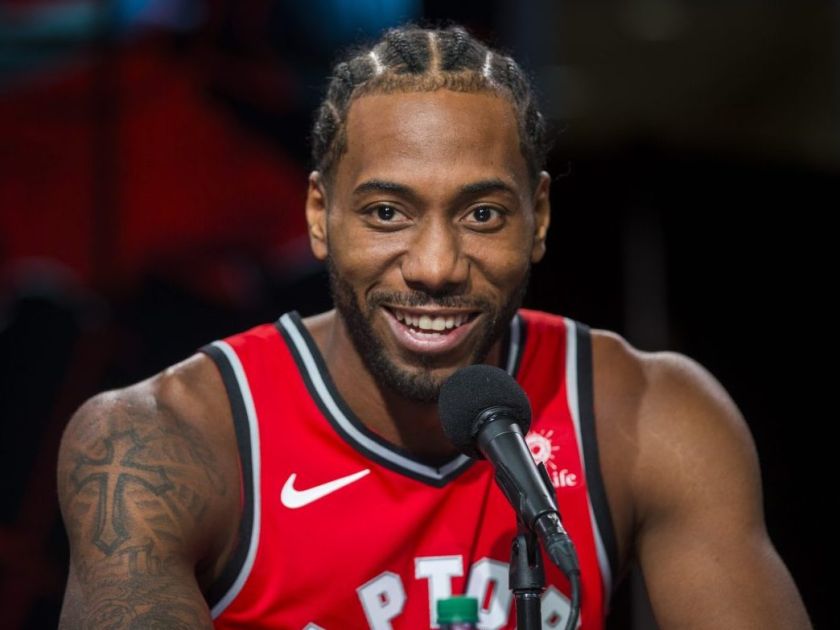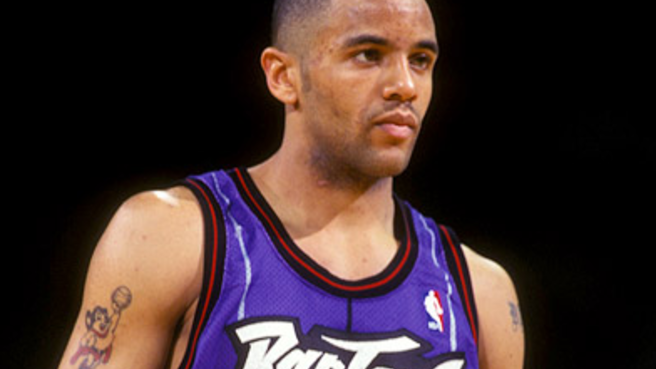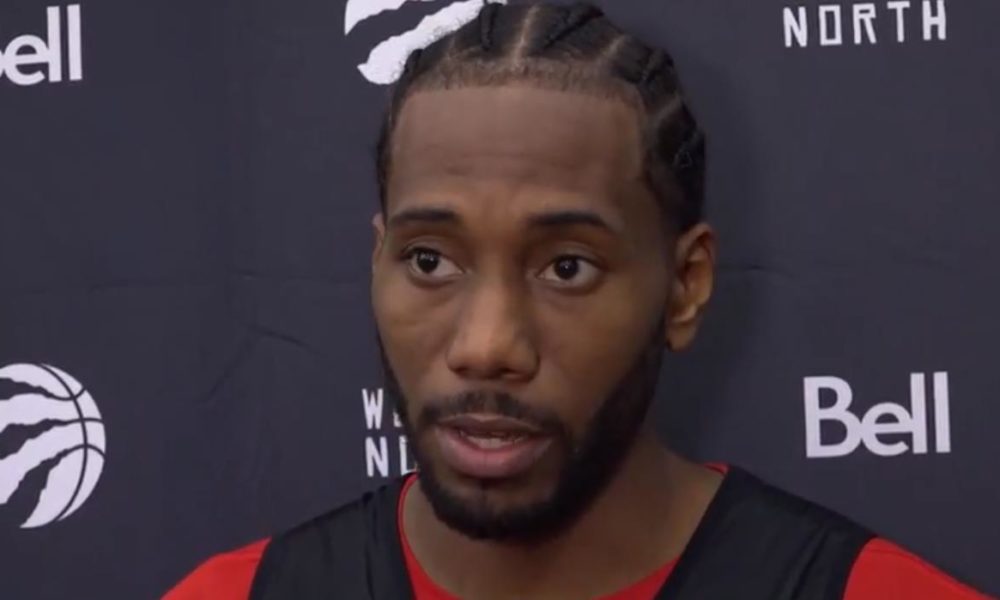You can keep up with all of our player previews here.
It is tempting to assume that the Raptors have acquired a fully healthy Kawhi Leonard, harkening back to his MVP-caliber 2016-17 season. That is entirely possible. However, previewing a season is about predicting a range of possibilities, and it’s too easy to forget Leonard’s on-court performance during his 2017-18 season. He played in only nine games hampered by a lingering quad injury, and the team’s performance during that stretch was subpar. Which Leonard will Toronto get?
Before delving into possible outcomes, first let’s discount impossible outcomes. Leonard is not going to sit out the season. He has expressed, personally and through his camp, nothing but willingness to give Toronto a try. He will not refuse to report and hold out for smokier and smoggier pastures in Los Angeles. Leonard may not love Toronto, and he may not re-sign here. I’ll leave those prognostications to wordsmiths who care more about dunking on delayed press conferences than dunking on …you know…. defenders.
But when Leonard does get on the court, there are several outcomes that anybody could predict. Most importantly, Leonard will be Toronto’s best wing defender; his injury did not seem to impact his defensive play. In the nine games in which Leonard did play in 2017-18, he was still one of the league’s best defenders.
Leonard posted the highest block and steal rates of his career while fouling less often than he had ever before. Players shot well below their average when Leonard defended their shots, whether at the rim or behind the arc. He was terrific in pretty much every situation, and his team was much better defensively when he played.
Among players who defended the ball-handler of the pick-and-roll more than once per game, Leonard forced the fourth-most turnovers per game in the league, just ahead of Andre Roberson. He forced oodles of turnovers whether defending cuts, spot up shooters, or handoffs.
He snatched steals like these
And collected blocks like these
Part of Leonard’s defensive dominance was a result of him guarding a team’s second-best wing. Because Leonard was asked to do so much on offence – more on that to come – the Spurs did not ask him to carry the world on the other end. The Raptors should do something similar. Expect O.G Anunoby to continue matching up against teams’ most threatening perimeter attackers somewhat frequently.
One defensive issue for Leonard last year, and the year previous, was focus. He occasionally was beaten by simple back cuts or closed out sloppily against non-shooters. Part of that was the immensity of his responsibilities. He Those will not lessen in Toronto, so don’t expect Leonard to match up against the Bradley Beals of the world.
Leonard is a unique defensive player. He is matchup-proof, switchable, and capable of single-handedly defending practically any non-center in the league. He creates huge numbers of live-ball turnovers without sacrificing positioning, which is not supposed to be possible. He is a fantastic defensive rebounder. Oh, and he doesn’t foul. None of that changed last year, despite Leonard playing so few minutes and seemingly taking a step backwards due to injury. Basically, it is an impossible outcome that Leonard is anything less than an MVP-caliber defender.
The uncertainty of possible outcomes lies within Leonard’s offensive game. Leonard changed on offence last year, but it was subtle and buried deep in the numbers. On the surface, he played similarly. His usage rate stayed sky-high (top-10 in the league in both 2016-17 and 2017-18), while he remained an elite passer and low-turnover player. He took his shots from practically the same areas on the floor as he had in years past.
Per Cleaning the Glass, Leonard is a high-frequency midrange shooter who takes relatively few shots at the rim or behind the arc. The coloured numbers represent percentile rank among players at the same position.

(You know whose shot-chart that resembles?)
![]()
Following the similarity in Leonard’s and DeRozan’s shot choices, Leonard last year became a middling-efficiency offensive player after posting league-leading rates in every year of his career previous. What happened?
Leonard simply started missing shots. Much of this is small sample size theater; the man only played in nine games for 207 minutes in 2017-18. Missing a handful of jumpers in a cold quarter have an outsized effect on percentages during such a season; however, the percentages were ugly.
Leonard shot 31.4 percent on triples, the lowest of his career. He was even worse taking shots that should have been easier – catch-and-shoot triples – notching 26.3 percent on those bunnies. (His pull-up triples remained stellar, at 37.5 percent, up from 30.4 percent the season before.)
How much of his low percentages stemmed from his quad injury and how much from sheer luck is difficult to say. Quad injuries affect all upright motion, which should include defensive actions, such as sliding, recovering, and contesting. Leonard remained elite at those, while his standstill jumper instead seemed affected. That speaks to small sample sizes. Furthermore, that his pull-up shooting improved on his previous percentages could only be explained by small sample sizes. Leonard’s shooting numbers ought to normalize this season, but that is far from a given.
What’s important to note is that a still-injured Kawhi Leonard with a weakened jumper is not an MVP-caliber offensive player. Last year the Spurs were 7.4 points per 100 possessions better on offence with Leonard off the court, the worst mark of Leonard’s illustrious career. The team took fewer shots at the rim and more from midrange when Leonard ran the show. However, Leonard was still effective in a variety of situations.
Despite missing shots, Leonard played the same as he had in past years. He is at his most comfortable running the pick-and-roll. Per nba.com, he ran the pick-and-roll more frequently and with higher efficiency than Steph Curry in both 2017-18 and 2016-17. The only high-frequency players who scored more efficiently than Leonard out of the pick-and-roll in 2016-17 were Kyle Lowry, Isaiah Thomas, and Damian Lillard. No one scored more efficiently than Leonard last year.
How can this possibly jive with Leonard shooting so poorly? Well, he’s still a high-level passer. Leonard makes immediate reads and almost always passes with pace. That allowed brilliant perimeter attackers like Manu Ginobili and Kyle Anderson open driving lanes, and Kyle Lowry will certainly find more room when Leonard runs the show. Secondary attackers like Fred Van Vleet and Delon Wright will find oodles of space when playing alongside Leonard.
When Leonard does get to the rim, he’s a fantastic finisher, due to his unmatched size and strength. He’s great at absorbing contact and choosing simple finishing moves while keeping his balance. His reputation as an ugly but effective finisher is overblown; he can do far prettier things around the rim than the casual observer would expect.
Leonard is also a terrific midrange shooter, ranking in the 91st percentile for his position.
Still, there is a cap to an offence led by a pick-and-roll maestro who’s elite in the midrange. Does this look like anything you recognize?
The Spurs met an offensive ceiling last year whenever Leonard ran the show. When he didn’t have the ball, he frequently spent entire possessions calling for it either in the post or above the key. Leonard is a solid cutter and screen-setter, but his high usage rate and occasional frustration with teammates’ gaffes meant that he didn’t utilize his off-ball skills nearly enough.
Leonard’s involvement in Toronto’s offence will thus present a question mark. The Raptors’ offence should be great, but the ceiling will be determined by Leonard’s health and role. Nick Nurse will likely run an offence characterized by whirring motion, off-ball cuts, and improvisational reads. Even though that was the Spurs’ way as recently as a few years ago, that has not become Leonard’s natural inclination. He is most comfortable as a team’s de facto point guard, running scripted pick-and-rolls and dicing apart the defence from the midrange. His jumper needs to be back to 2016-17 levels for that style to be effective.
That’s where the uncertainty of outcome comes into play for Leonard. His jumper could return along with his healthy quad, making him such an elite pick-and-roll orchestrator that the Raptors’ offence could break records. Leonard improved the Spurs’ offence massively in 2016-17 whenever he was on the floor. Even if Leonard doesn’t approach the high-30s from behind the arc, he could still make up for it with quick reads, smart cuts, and strong screens. Lowry can take charge and allow Leonard to thrive off-ball for stretches. As long as he’s on the floor, Leonard will be a positive on offence; the only question is to what extent.
Toronto has more offensive creators than San Antonio did last year. Leonard’s usage rate should drop into the mid- to high-20s, but he will be the team’s primary creator whenever he’s on the floor. At best, the Raptors will be an offensive juggernaut with two or three lead creators on the floor at all times, and three to four knockdown shooters. They’ll make quick decisions, swinging the ball multiple times on each possession, and yield great shots in the half-court. At worst, the Raptors will be a very good offensive team that doesn’t optimize its shot distribution. The difference will be decidedly by several variables, including Leonard’s jumpshot and quad health.
The Raptors’ defence will certainly be a terror. It will be matchup-proof and built for the playoffs, with multiple possible lineups for every situation. It will have an elite defender capable of checking a dominant point guard or wing on the floor for 48 minutes a game. It will be able to play conservatively and force a huge number of contested shots in the paint and midrange, clean its own glass, and also create live-ball turnovers.
Despite getting swept out of last year’s playoffs, Toronto’s lofty incoming expectations are due to the presence of Kawhi Leonard. As long as he’s on the floor – even if not playing at the level of his 2016-17 season – the Raptors are legitimate finals contenders. A truly healthy Leonard could help Toronto maybe even take a game off of Golden State. The Raptors have a range of possible outcomes this season, and they will greatly be decided by Leonard’s health and play. That in itself already shows his importance to a franchise for which he’s not yet played a game.



